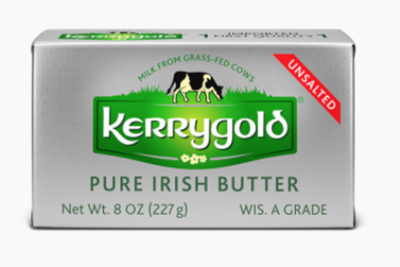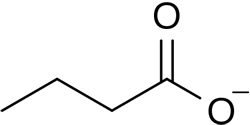Why is grass fed butter better for you?
 Grass Fed Irish Butter
Grass Fed Irish Butter
What is grass fed butter?
To make grass-fed butter, you need milk from grass-fed cows. Grass-fed cows are allowed to graze on green, grassy pastures, which is the best food source for them and the one they're physiologically designed to eat. The problem of course is how is it possible to feed on grass 12 months a year.
According to the Journal of Dairy Science-- source , grass-fed butter is packed with five times more conjugated linoleic acid (CLA) than regular butter from grain-fed cows. ---"... Cows grazing pasture and receiving no supplemental feed had 500% more conjugated linoleic acid in milk fat than cows fed typical dairy diets..." (CLA is a powerful fatty acid, known for its anti-inflammatory properties and weight-loss benefits. Omega-3 fatty acids also share the spotlight—DHA and EPA—with anti-inflammatory benefits for certain conditions, like eczema and arthritis.
Note:"...But for the first seven months of life, all cattle are “grass fed cows”. They graze on grass, drink their mother’s milk, and spend a lot of time in pasture (I took the photo above at a conventional cattle farm here in Ohio). It’s only when they’re transferred from the pasture to the feedlot that they’re fed a diet that’s higher in grain (about 65-70 percent corn but still contains some hay and other forage) for the last 6-8 months of their lives...
...All cattle eat grass. If you want to buy grass fed beef from cattle that have spent their entire lives eating only grass, make sure you’re getting 100% grass-fed beef, sometimes called “grass finished beef...." source
"...But as with conventional beef, there are no restrictions on pesticide use on the farm or use of antibiotics.. for all grass fed". So you have to check labels to make sure your grass fed beef or butter is also organic".
Grass-Fed Butter Ingredients
VITAMIN K2, OMEGA 3, AND BUTYRATE
Butter is basically just milk fat, also known as butterfat. Butterfat is highly complex. ... Grass-fed butter contains 5 times more CLA than butter from grain-fed cows.
Butter from grass-fed cows is also much higher in Omega-3 fatty acids and vitamin K2, compared to butter from grain-fed cows source: Increased concentrations of omega-3 fatty acids in milk and platelet rich plasma of grass-fed cows. The level of butyrate (see below) is also higher in grass fed butter.
What is Butyrate?
The molecule shown here is butyrate in a ball-and-stick configuration.

Butyrate or butanoate is the traditional name for the conjugate base of butyric acid (also known as butanoic acid). The formula of the butyrate ion is C 4H 7O− 2. Butyrate is a functionally versatile molecule that is produced in the mammalian gut by fermentation of dietary fibre and is enriched in butter and other dairy products.
Health Benefits of Butyrate
"...At the intestinal level, butyrate exerts multiple effects such as the prevention and inhibition of colonic carcinogenesis, the improvement of inflammation, oxidative status, epithelial defense barrier, and the modulation of visceral sensitivity and intestinal motility. At the extraintestinal level, potential fields of application for butyrate seem to be the treatment of sickle cell disease, β-thalassemia, cystic fibrosis, urea cycle enzyme deficiency, X-linked adrenoleukodystrophy, hypercholesterolemia, obesity, insulin resistance, and ischemic stroke. In conclusion, a growing number of studies have revealed new mechanisms and effects of butyrate with a wide range of potential clinical applications from the intestinal tract to peripheral tissues. However, more clinical studies to elucidate the role of butyrate in health and diseases and new solutions for easier administration are needed..." See: Potential beneficial effects of butyrate in intestinal and extraintestinal diseases
Where to find grass fed butter?
If you’re looking for grass-fed butter it can be found at Trader Joe’s, Whole Foods Market, Aldi, and Costco.
Sources:
Fats in Cooking and Health
- What are the differrent types of fatty acids?
- What are Trans Fats?
- What is the difference between LDL and HDL?
- What are the different types of omega 3 fatty acid?
- What are omega-6 fatty acids?
- The importance of the ratio of omega-6/omega-3 essential fatty acids
- What is the difference between saturated and unsaturated fats?
- What causes oils to go rancid?
- What are essential fatty acids?
- Duck Fat as an alternative to butter
- How to render duck fat
- Did butter get a bad rap?
Types of Fatty Acids
Saturated